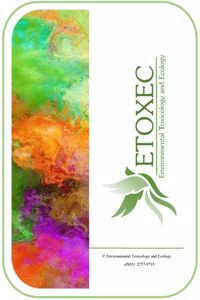Kozmetik Sektöründe Kullanılan Biyolojik Yüzey Aktif Madde ile Organik Kirleticilerin Islah Performansının Değerlendirilmesi
Trikloroetilen (TCE) yeraltı suyu akifer sistemlerinde en çok gözlenen klorlu organik bileşiklerden biri olup kanserojen etkisinden ötürü insan sağlığı için ciddi tehlike oluşturmaktadır. Bu bileşikler yeraltına genellikle DNAPL olarak girerek genel olarak matriks ve akiferlerin tabanını oluşturan kil ya da ana kaya içerisinde (çanak) yüksek doygunlukta depolanarak uzun süreli çözünmüş faz kirletici kaynağı üretmektedir. Yerinde kimyasal yıkama teknolojisi organik kirleticilerin yeraltından uzaklaştırılması için kullanılan önemli ıslah tekniklerindendir. Çalışmanın amacı; akifer sistemlerin tabanında depolanmış yüksek doygunluktaki DNAPL kütlelerinin kozmetik sektörümde kullanılan biyolojik yüzey aktif madde olan rhamnolipid ile ıslah performansının değerlendirilmesidir. Kimyasal yıkama ile heterojen sistemlerde depolanan TCE kaynak zonları büyük oranda ıslah edilmesine rağmen, fiziksel ortam heterojenliği geniş ölçekte aşamalı konsantrasyon davranışı sergilemiştir. Sonuçlara göre, yıkamanın ilk anlarında organik kirletici hidrolik olarak elverişli zonlardan (matriks) gelirken, geç zamanlarda yüksek doygunluktaki hidrolik olarak elverişli olmayan zonlardan (çanak) gelmektedir. Ayrıca, DNAPL kaynak zonlarının dağılımı, doygunluğu ve yüzey aktif madde konsantrasyonu belirgin bir şekilde ıslah performansına etki etmiştir. Sonuç olarak, bu çalışmadan elde edilecek sonuçlar, ulusal ve uluslararası alandaki önemli bilgi eksikliğine katkıda bulunacak ve arazi uygulamalarının geliştirilmesine yardımcı olacaktır.
Anahtar Kelimeler:
DNAPL, Kozmetik, Rhamnolipid, Trikloroetilen, Yüzey aktif madde
Assessment for Remediation of Organic Contaminants Using Cosmetic Biological Surfactant
Contamination of groundwaters by chlorinated solvents such as trichloroethylene (TCE) is a widespread problem around the world and causes serious threat for human health due to being human carcinogen. Chlorinated solvents generally enter the subsurface as dense non aqueous phase liquids (DNAPL) and accumulation generally occurs in aquifers where the DNAPL mass is most likely pooled at the bottom of aquifers and become a long-term aqueous phase source zone for groundwater contamination. In situ immobilization or remediation of DNAPL source zones in such systems is crucial for protecting aquifer systems having significant groundwater potential. In situ chemical flushing (ISCF) is groundwater remediation techniques used to remove organic pollutants from the subsurface environment. The objective of the project is to test the enhanced-solubilization potential of cosmetic ramnolipid surfactant flushing performances for the specific scenario of DNAPL sources trapped in heterogeneous aquifer media. The results emphasized that in the early stage, some portion of organic liquid is hydraulically accessible (matrix) whereas the later stage of mass removal was controlled by the more poorly-accessible mass (pool) associated with higher-saturation zones. Our results also showed that the distribution and the emplacement of organic liquid, flow-field heterogeneity, flushing solution and its concentration significantly influence on remediation effort. As a result, the performance of technology depends on the site characteristics which are critical to characterize effective DNAPL remediation strategies for contaminated sites.
Keywords:
DNAPL, Cosmetic, Rhamnolipid, Trichloroethene, Surfactant,
___
- [1] Akyol N.H. Surfactant-enhanced permanganate oxidation on mass-flux reduction and mass removal relationship for pool-dominated TCE source zones in heterogeneous porous media. Water, Air and Soil Pollution, 2018, 229(285).
- [2] Akyol N.H, Russo Lee A. and Brusseau M.L. Impact of enhanced-flushing reagents and organic liquid distribution on mass removal and mass discharge reduction. Water, Air and Soil Pollution, 2013, 224:1731.
- [3] Clifford, J.S., Ionnidis, M.A. ve Legge, R.L., Enhanced aqueous solubilization of tetrachloroethylene by a rhamnolipid biosurfactant. J. Colloid. Interfac. Sci. 2007, 305:361–4.
- [4] Dickson J. R., Stenson R. Insufficient source area remediation results in the rebound of TCE breakdown products in groundwater, Remediation, 2011, 87-103.
- [5] Dudu-Gül, Ülküye. Mikrobiyel Yüzey Aktif Maddeler ve Çevresel Uygulamalarda Kullanımı. Mikrobiyoloji Dergisi, 10 (2), 2012, 45-55.
- [6] Difilippo E.L., Carroll K.C. ve Brusseau M.L. Impact of organic-liquid distribution and flow-field heterogeneity on reductions in mass flux. Journal of Contaminant Hydrology, 2010,115:14-25.
- [7] Feenstra S., Cherry J. A. Subsurface contamination by dense non-aqueous phase liquid (DNAPL) chemicals, The International Association of Hydrogeologists, Halifax, Nova Scotia, 1988.
- [8] Karaoglu Aybike Gul, Copty Nadim K., Akyol Nihat Hakan, Aslan Kılavuz Seda, Babaei Masoud. Experiments and sensitivity coefficients analysis for multiphase flow model calibration of enhanced DNAPL dissolution. Journal Of Contaminant Hydrology,2019, 225(null).
- [9] Mercer J. W., Cohen R. M. A review of immiscible fluids in the subsurface: Properties, models, characterization and remediation, Journal of Contaminant Hydrology, 6, 1990, 107-163.
- [10] Mohammed M., Özbay I., Akyol G., Akyol N.H., Şahin Y., Özbay B., Türkkan S., Karataş, T. Optimizing process parameters on the remediation efforts for the mass removal of DNAPL entrapped in a porous media. Water, Air, Soil Pollution, 2019, 230 (7).
- [11] National Research Council (NRC). Alternatives for groundwater cleanup, National Academy of Sciences, 1994, Washington D.C.
- [12] Pankow, J. F., Cherry, J. A. 1996. ‘‘Dense chlorinated solvents and other DNAPLS in groundwater’’, History, Behavior, and Remediation, Waterloo Press, Portland, Orego
- Yayın Aralığı: Yılda 2 Sayı
- Başlangıç: 2021
- Yayıncı: Ekoloji ve Ekotoksikoloji Derneği
